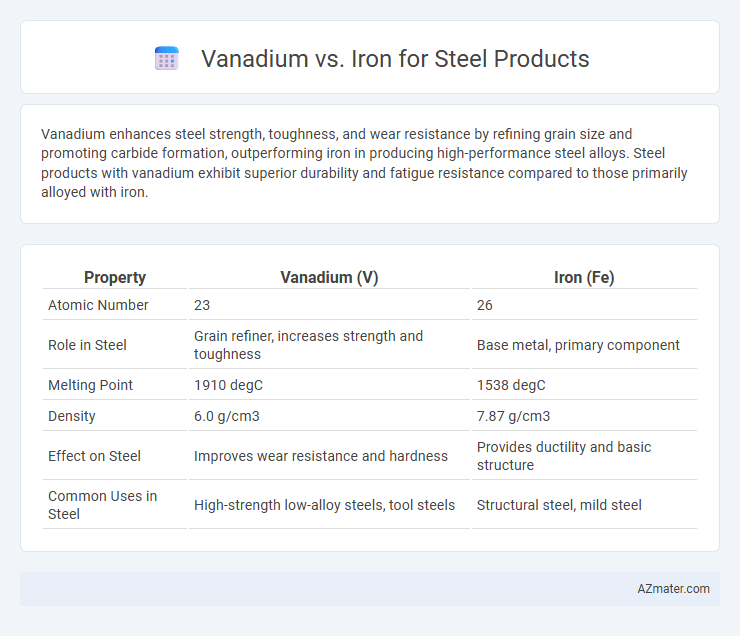Vanadium enhances steel strength, toughness, and wear resistance by refining grain size and promoting carbide formation, outperforming iron in producing high-performance steel alloys. Steel products with vanadium exhibit superior durability and fatigue resistance compared to those primarily alloyed with iron.
Table of Comparison
| Property | Vanadium (V) | Iron (Fe) |
|---|---|---|
| Atomic Number | 23 | 26 |
| Role in Steel | Grain refiner, increases strength and toughness | Base metal, primary component |
| Melting Point | 1910 degC | 1538 degC |
| Density | 6.0 g/cm3 | 7.87 g/cm3 |
| Effect on Steel | Improves wear resistance and hardness | Provides ductility and basic structure |
| Common Uses in Steel | High-strength low-alloy steels, tool steels | Structural steel, mild steel |
Introduction to Vanadium and Iron in Steel Production
Vanadium and iron are essential elements in steel production, each contributing unique properties to the alloy. Iron serves as the primary metal, providing the fundamental strength and structure, while vanadium acts as a micro-alloying element that enhances toughness, wear resistance, and fatigue strength. Incorporating vanadium at low concentrations significantly improves steel's mechanical performance without compromising its ductility, making it ideal for high-strength and long-lasting steel products.
Chemical Properties: Vanadium vs Iron
Vanadium exhibits multiple oxidation states, primarily +3, +4, and +5, which contribute to its strong ability to form stable carbides that enhance steel hardness and wear resistance. In contrast, iron mainly exists in +2 and +3 oxidation states, making it more reactive but less effective in carbide formation crucial for strengthening steel alloys. The chemical stability of vanadium carbides compared to iron carbides significantly improves steel toughness and resistance to deformation at high temperatures.
Impact on Steel Strength and Hardness
Vanadium significantly enhances steel strength and hardness by forming fine vanadium carbides and nitrides that refine grain size and improve wear resistance. Iron, as the base metal, provides the primary matrix, but its mechanical properties can be vastly improved through vanadium alloying. The addition of vanadium results in higher tensile strength, better toughness, and superior hardness compared to standard iron-based steel products.
Corrosion Resistance Comparison
Vanadium enhances steel's corrosion resistance by forming stable carbides and refining grain structure, improving toughness and resistance to oxidative damage compared to iron-based steels. Iron alone, while fundamental to steel composition, lacks the microstructural benefits provided by vanadium, resulting in lower resistance to rust and environmental degradation. Incorporating vanadium in steel alloys significantly extends service life in corrosive environments compared to conventional iron-centric steel products.
Influence on Steel Ductility and Toughness
Vanadium significantly enhances steel ductility and toughness by refining grain structure and promoting precipitation strengthening, which restricts dislocation movement and improves impact resistance. In contrast, iron, as the base metal, provides the fundamental matrix but offers limited intrinsic improvement to ductility without alloying elements. The addition of vanadium results in finer, more uniform microstructures, leading to superior fatigue resistance and toughness compared to plain carbon steel.
Energy Efficiency and Processing Differences
Vanadium enhances steel's strength and hardness significantly, allowing for lower material usage and improved energy efficiency during processing compared to iron. Vanadium-alloyed steels require less energy-intensive heat treatment due to their refined microstructure, resulting in reduced carbon emissions in manufacturing. Iron-based steels demand higher processing temperatures and longer cooling times, leading to increased energy consumption and cost inefficiencies in steel production.
Cost Implications of Vanadium and Iron Alloys
Vanadium alloys typically increase the overall cost of steel products due to the higher price of vanadium compared to iron, driven by its scarcity and complex extraction process. While iron alloys remain more economical for mass production, vanadium enhances steel strength and wear resistance, sometimes reducing total lifecycle costs despite the initial premium. The decision between vanadium and iron alloys depends heavily on balancing upfront material costs against performance benefits and application-specific requirements.
Common Applications in Industrial Sectors
Vanadium is primarily used in high-strength steel alloys for aerospace, automotive, and construction industries due to its ability to enhance toughness, wear resistance, and fatigue strength. Iron, being the principal component of steel, serves as the base metal in structural steel, machinery, and transportation sectors where cost-efficiency and versatility are crucial. Industries like oil and gas pipelines, heavy machinery, and tool manufacturing rely heavily on vanadium-infused steels for performance under extreme conditions, whereas iron-based steels dominate in infrastructure and general fabrication applications.
Environmental Considerations and Sustainability
Vanadium significantly enhances steel strength, enabling thinner, lighter structures that reduce raw material use and lower carbon emissions in production compared to traditional iron-based steel. Vanadium microalloyed steel offers improved recyclability and extends product lifespan, contributing to circular economy goals and reducing environmental impacts. Iron remains essential but the integration of vanadium is driving sustainable steel innovation with greater energy efficiency and reduced ecological footprint.
Future Trends in Steel Alloy Innovation
Vanadium-driven steel alloys are gaining prominence due to their superior strength, wear resistance, and ability to retain toughness at high temperatures compared to traditional iron-based steels. Innovations in nanostructured vanadium microalloys enable the development of lightweight, high-performance steel products crucial for automotive and aerospace industries aiming for fuel efficiency and reduced emissions. Ongoing research emphasizes combining vanadium with advanced alloying elements to create smart, corrosion-resistant steel materials tailored for sustainable infrastructure and green technology applications.

Infographic: Vanadium vs Iron for Steel Product
 azmater.com
azmater.com